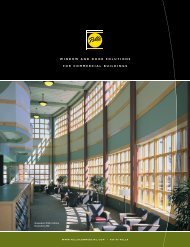Building Operating Management September 2011 - FacilitiesNet
Building Operating Management September 2011 - FacilitiesNet
Building Operating Management September 2011 - FacilitiesNet
Create successful ePaper yourself
Turn your PDF publications into a flip-book with our unique Google optimized e-Paper software.
68<br />
buildingoperatingmanagement<br />
SEPTEMBER <strong>2011</strong><br />
ROOFING<br />
SIKA SARNAFIL<br />
The project team<br />
for the new<br />
248,000-square-foot<br />
building for Stansbury<br />
High School in<br />
Stansbury Park, Utah,<br />
used several LEED<br />
strategies, including<br />
a reflective roof.<br />
A New Roofing<br />
Golden Age?<br />
Environmental regulations are spurring the roofing<br />
industry to make changes to practices and products<br />
by john d’annunzio<br />
For a comprehensive list<br />
of roofing-related codes<br />
and standards, visit:<br />
www.coolroofs.org/codes_<br />
and_programs.html<br />
In the last decade there has been an<br />
intensive effort in the United States<br />
to address health, safety and environmental<br />
issues in relation to roofing<br />
materials. Driven by codes, regulations<br />
and concerns about depletion<br />
of natural resources, the industry has<br />
developed technologies and materials<br />
that will be used from this point<br />
forward. Facility managers who understand<br />
these new materials and<br />
codes will be in the best position to<br />
take advantage of innovations that are<br />
reshaping the roofing industry.<br />
As we enter the second decade of<br />
the 21st century, many modifications<br />
are being made to low-slope roofing<br />
systems. The recent changes are minor<br />
modifications compared to the vast<br />
changes that occurred near the end of<br />
the 1990s. In the time period from the<br />
1980s through the end of the 1990s, the<br />
low-slope roofing market witnessed its<br />
greatest changes in materials and technologies<br />
since World War II.<br />
The changes — which included<br />
advances in single-ply and modified<br />
bitumen systems, as well as the<br />
reduction in use of hot-applied systems<br />
and increased use of cold-applied<br />
and self-adhered membranes<br />
— were largely driven by econom-





